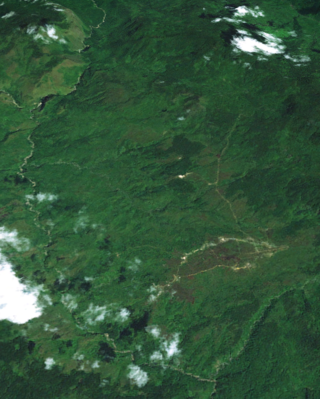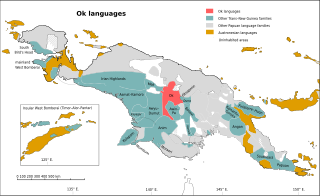The Border or Upper Tami languages are an independent family of Papuan languages in Malcolm Ross's version of the Trans–New Guinea proposal.

The Telefomin cuscus is a critically endangered possum found on New Guinea.

Oksapmin is a Trans–New Guinea language spoken in Oksapmin Rural LLG, Telefomin District, Sandaun, Papua New Guinea. The two principal dialects are distinct enough to cause some problems with mutual intelligibility.

Telefomin is a station town on the border of Sandaun and Western Provinces in Papua New Guinea. The town started during the Second World War after Mick Leahy was assigned to engineer an airstrip in 1944 for the United States for use against the Imperial Japanese Army forces based in New Guinea.
This is an article about the extreme points of Indonesia.

The Central and South New Guinea languages (CSNG) are a proposed family of Trans–New Guinea languages (TNG). They were part of Voorhoeve & McElhanon's original TNG proposal, but have been reduced in scope by half in the classification of Malcolm Ross. According to Ross, it is not clear if the pronoun similarities between the four remaining branches of Central and South New Guinea are retentions for proto-TNG forms or shared innovations defining a single branch of TNG. Voorhoeve argues independently for an Awyu–Ok relationship, and Foley echoes that Asmat may be closest to Awyu and Ok of the TNG languages. Regardless, the four individual branches of reduced Central and South New Guinea are themselves clearly valid families.

The Angan or Kratke Range languages are a family of the Trans–New Guinea languages in the classification of Malcolm Ross. The Angan languages are clearly valid as a family. They were first identified as such by J. Lloyd and A. Healey in 1968; Wurm (1975) classified them as Trans–New Guinea. Glottolog treats Angan as a separate or unclassified family, ignoring further evidence.

The Ok languages are a family of about a dozen related Trans–New Guinea languages spoken in a contiguous area of eastern Irian Jaya and western Papua New Guinea. The most numerous language is Ngalum, with some 20,000 speakers; the best known is probably Telefol.
Suki is a Gogodala-Suki language spoken by about 3500 people several miles inland along the Fly River in southwestern Papua New Guinea.
Telefol is a language spoken by the Telefol people in Papua New Guinea, notable for possessing a base-27 numeral system.
The Urapmin people are an ethnic group numbering about 375 people in the Telefomin District of the West Sepik Province of Papua New Guinea. One of the Min peoples who inhabit this area, the Urapmin share the common Min practices of hunter-gatherer subsistence, taro cultivation, and formerly, an elaborate secret cult available only to initiated men.
Tifal is an Ok language spoken in Papua New Guinea. Dialects are (1) Tifal (Tifalmin) and Urap (Urapmin) and (2) Atbal (Atbalmin).

The Sepik is the longest river on the island of New Guinea, and the second largest in Oceania by discharge volume after the Fly River. The majority of the river flows through the Papua New Guinea (PNG) provinces of Sandaun and East Sepik, with a small section flowing through the Indonesian province of Papua.
Deraa.k.a.Mangguar and Kamberataro (Komberatoro) is a Senagi language of Papua New Guinea and Indonesia. In Papua New Guinea, it is primarily spoken in Kamberataro village, Amanab Rural LLG, Sandaun Province.
Namia is a Sepik language spoken in Namea Rural LLG, Sandaun Province, Papua New Guinea. It goes by various names, such as Edawapi, Lujere, Yellow River. Language use is "vigorous" (Ethnologue).
Sanio, or more precisely Saniyo-Hiyewe, is a Sepik language of Tunap/Hunstein Rural LLG in East Sepik Province, northern Papua New Guinea. It is also spoken in Telefomin Rural LLG, Sandaun Province.
McIntyre's horseshoe bat is a species of horseshoe bat that is endemic to Papua New Guinea.
Oksapmin Rural LLG is a local-level government (LLG) of Sandaun Province, Papua New Guinea. The Oksapmin language is spoken in the LLG.
Proto-Trans–New Guinea is the reconstructed proto-language ancestral to the Trans–New Guinea languages. Reconstructions have been proposed by Malcolm Ross and Andrew Pawley.







